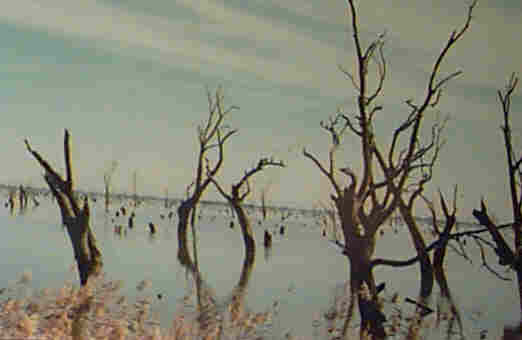

 |
The Enigma of Kow Swamp |  |
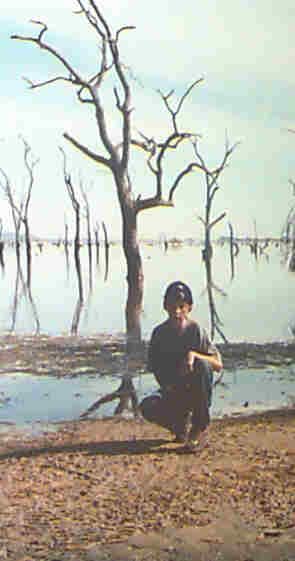 Back
in May, 1999, I travelled to Kow Swamp to take some pictures and
have a general look around. The story of Australia's "archaics" has me
so thoroughly intrigued that I have been collecting the original papers
relating to the discoveries and I wanted to view the actual sites for myself.
Read the attached article, linked below, to see what I've got so far.
Back
in May, 1999, I travelled to Kow Swamp to take some pictures and
have a general look around. The story of Australia's "archaics" has me
so thoroughly intrigued that I have been collecting the original papers
relating to the discoveries and I wanted to view the actual sites for myself.
Read the attached article, linked below, to see what I've got so far.
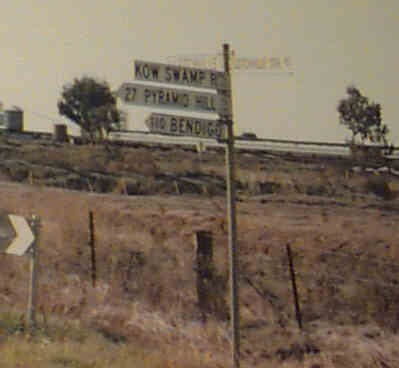
Let me assure interested parties that my approach was strictly on the basis of "looking but no touching". While I have the greatest respect for aboriginal Australians and their ancient culture, I think the question of whether the people found buried here can truly be said to be the ancestors of local indigenes is highly doubtful. However, certain lobby groups appear to have so claimed them and I have no special desire to buy into the argument.
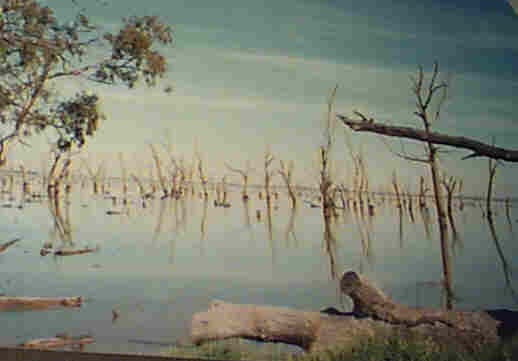 Kow Swamp lies in northern Victoria near the town of Cohuna on the Murray
River. It is a large, roughly oval shaped, body of fresh water which supports
a rich population of water fowl. Thick marshes make its northern end impenetrable.
A snake's idea of heaven, by the look of it. The surrounding country is
open farmland, flat as a billiard table from horizon to horizon : we're
standing in the Murray River's flood plain after all. The only high ground
visible in any direction is Mount Hope, a rocky outcrop a few miles to
the south west of Kow Swamp.
Kow Swamp lies in northern Victoria near the town of Cohuna on the Murray
River. It is a large, roughly oval shaped, body of fresh water which supports
a rich population of water fowl. Thick marshes make its northern end impenetrable.
A snake's idea of heaven, by the look of it. The surrounding country is
open farmland, flat as a billiard table from horizon to horizon : we're
standing in the Murray River's flood plain after all. The only high ground
visible in any direction is Mount Hope, a rocky outcrop a few miles to
the south west of Kow Swamp.
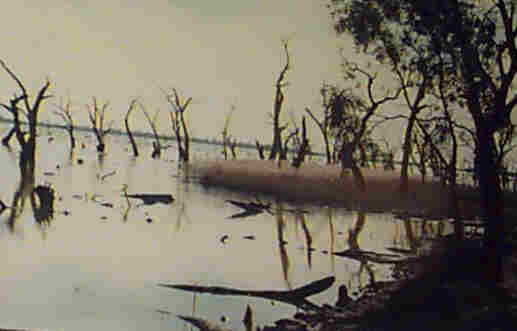 The
lake's level is maintained by Taylor's Creek, which supplies water
from the Murray River: The creek has been extensively reconstructed
by irrigation earthworks. Water is drained from the swamp by means of irrigation
channels at its western and northern sides and, after supplying irrigation
to farms, is returned to the Murray River. Virtually the entire length
of the Murray, from Albury to the South Australian border is an irrigation
district. The river's water is used and re-used before it reaches the sea.
The
lake's level is maintained by Taylor's Creek, which supplies water
from the Murray River: The creek has been extensively reconstructed
by irrigation earthworks. Water is drained from the swamp by means of irrigation
channels at its western and northern sides and, after supplying irrigation
to farms, is returned to the Murray River. Virtually the entire length
of the Murray, from Albury to the South Australian border is an irrigation
district. The river's water is used and re-used before it reaches the sea.
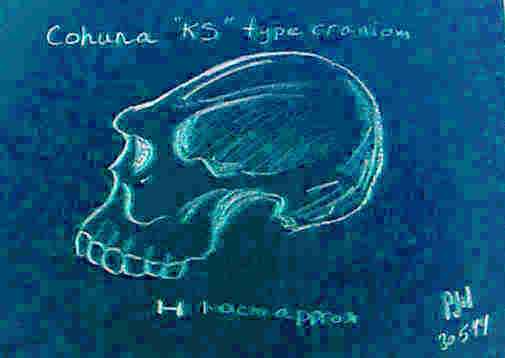 However,
burials have been uncovered in many sites around south eastern Australia
whose occupants appear to possess a cranial morphology reminiscent of a
much earlier species of humanity, Homo erectus. The remarkable thing
about these people is the recent dates attached to such burials: anything
from 13,000 up to 6,000 ybp. It means that there was a population living
in southern Australia up until comparatively recent prehistoric times who
appeared to have retained traits deriving from an ancient human forebear1.
However,
burials have been uncovered in many sites around south eastern Australia
whose occupants appear to possess a cranial morphology reminiscent of a
much earlier species of humanity, Homo erectus. The remarkable thing
about these people is the recent dates attached to such burials: anything
from 13,000 up to 6,000 ybp. It means that there was a population living
in southern Australia up until comparatively recent prehistoric times who
appeared to have retained traits deriving from an ancient human forebear1.
Moreover, the oldest accepted dates relating to the occupation of Australia by modern humans, Homo sapiens sapiens, appear to be in excess of 50,000 years1. Thus we have a paradox here : the "archaic" humans of Australia would appear to be younger than the "moderns".
This is the enigma presented to us by Kow Swamp.
Who were these people? What was their relationship, if any, to Homo erectus? One school of thought holds that they merely represent one end of a spectrum in the morphology of modern aboriginal people. Maybe. That did not seem to be the opinion of the palaeontologists who first described them. Times change. Perceptions accommodate to new realities. I don't really want to get into a political bun fight : go to the link below, download the images and just stand back and look at them. Modern?
Another, even more perplexing, question is - could any of them still be around? Hell, not around Kow Swamp, that's for sure, but ... somewhere? Is the story of Homo erectus and these mysterious archaics truly over? More on that below.
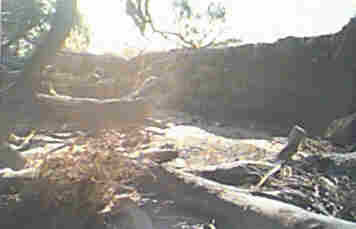 With
the help of Thorne's and others' articles1,
I located the original dig sites without difficulty. The irrigation bank,
below which one of the tool sites is located, has been greatly cut away
by wave action. Many large logs have been thrown up on the shore. Obviously,
the lake can present quite a different face from the placid aspect it showed
us on our visit. Not surprising : the water is shallow and the surrounding
country is flat, offering no protection from strong winds. This water body
is deceptively tranquil, I'd say. A fishing excursion in a small boat could
quickly turn deadly.
With
the help of Thorne's and others' articles1,
I located the original dig sites without difficulty. The irrigation bank,
below which one of the tool sites is located, has been greatly cut away
by wave action. Many large logs have been thrown up on the shore. Obviously,
the lake can present quite a different face from the placid aspect it showed
us on our visit. Not surprising : the water is shallow and the surrounding
country is flat, offering no protection from strong winds. This water body
is deceptively tranquil, I'd say. A fishing excursion in a small boat could
quickly turn deadly.
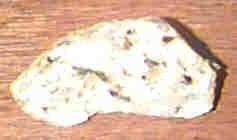
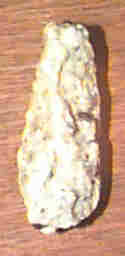 In
1975 Wright described excavations performed near the mouth of Taylor's
Creek which yielded quartz artefacts in association with the "KS14" burial
site. The area has since been greatly rearranged by wave action, exposing
large numbers of quartz and granite stones. It was possible to triangulate
the original TC 3/1 to TC 3/5 locations following Wright's
directions. Many stones had been revealed by wave action. To my untrained
eye, the one shown here appeared to be have been artificially worked and
possessed of a cutting edge. But whether this or any of the others represented
a genuine microlith I'm not really qualified to judge.
In
1975 Wright described excavations performed near the mouth of Taylor's
Creek which yielded quartz artefacts in association with the "KS14" burial
site. The area has since been greatly rearranged by wave action, exposing
large numbers of quartz and granite stones. It was possible to triangulate
the original TC 3/1 to TC 3/5 locations following Wright's
directions. Many stones had been revealed by wave action. To my untrained
eye, the one shown here appeared to be have been artificially worked and
possessed of a cutting edge. But whether this or any of the others represented
a genuine microlith I'm not really qualified to judge.
Besides, although Wright shows that the pieces were worked
at the site, the question of whether they were worked by the same people
who buried their dead there is less certain. That means we have no clear
proof that Kow Swamp type people were in command of a lithic technology
comparable to their "modern" counterparts who inhabited the same district.
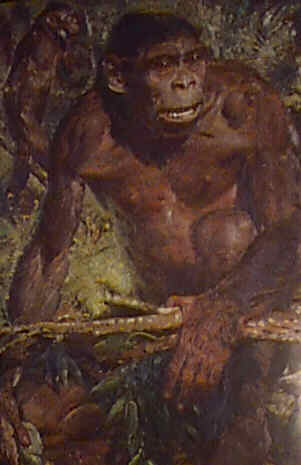 It
is, I hope, a part of general knowledge that the first hominid to make
it "out of Africa" was Homo erectus, the type specimen of which
was collected in Java in the late 19th century. H. erectus remained
a stable form for about a million years. The most recent known survivors
held out till a mere 27,000 ybp in islands off the coast of Timor. About
200, 000 ybp, the Neandertals, Homo sapiens neanderthalensis appeared.
They are supposed to have have arisen from H. erectus and formed
a distinctive group specifically adapted to tolerate the harsh conditions
of ice age Europe. The most recent known Neandertal remains date to about
28,000 ybp.
It
is, I hope, a part of general knowledge that the first hominid to make
it "out of Africa" was Homo erectus, the type specimen of which
was collected in Java in the late 19th century. H. erectus remained
a stable form for about a million years. The most recent known survivors
held out till a mere 27,000 ybp in islands off the coast of Timor. About
200, 000 ybp, the Neandertals, Homo sapiens neanderthalensis appeared.
They are supposed to have have arisen from H. erectus and formed
a distinctive group specifically adapted to tolerate the harsh conditions
of ice age Europe. The most recent known Neandertal remains date to about
28,000 ybp.
African Eve ...
(See NOTE #1)
If the molecular biologists and the story told by our
mitochondrial
DNA by are to be believed, about 150,000 ybp, a very special woman
lived somewhere in Africa. In her life she may have suffered trauma and
heartbreak for all her people and all her people's children died. Well,
so one possible scenario goes. But she, and at least some of her children
did not die out. They lived on, they went forth from Africa and their descendants
took possession the Earth. They are us, Homo sapiens sapiens, and
that woman alone was the Mother of our race.
Thus it was that, a mere 30,000 ago, three distinct species, as distinct from modern day races, of humanity inhabited the Earth. However by 10,000 ybp, at the transition from the Pleistocene to the Holocene era, only one kind of human remained : Homo sapiens sapiens, modestly the "double wise man". By the beginning of the Holocene we had spread to all land masses on the planet, save for Antarctica, and, in a few places, were beginning to experiment with farming.
What happened to those others, to our cousins left behind?
For, it seems to me, something truly extraordinary took place at the close of the Pleistocene. The great Ice Age ended, the glaciers melted, seas rose by hundreds of metres and flooded the land. Animals such as mammoths, sabre tooth tigers, diprotodons, the giants which are collectively called the Pleistocene Megafauna, almost all died. And quickly too. All continents felt the holocaust, some catastrophically, others less severely. In North America, the extirpation of the megafauna took place in less than 1000 years, a blink of an eye, geologically speaking. Perhaps even quicker, for the resolution of the fossil beds and C14 dates don't allow us to discriminate more finely.
It's held by some that our forebears out competed, out hunted, out fought and replaced the others, the primitive, slope-headed, beetle-browed, dim-witted ape-men and women who could not compete, who were unfit in the darkest Darwinian sense.
The fact that our own direct ancestors are usually heroically
portrayed as high browed, white Anglo-saxon types, if not Protestant then
at least blond and Teutonic looking, is taken as a matter of course. Like
Aylar
and Jondalar in Jean Auel's Clan of the Cave Bear novels.
Agreeable flattery regarded as only proper by the self satisfied victors.
Admittedly, inheriting the family estate because our brothers and sisters got hit by a truck is rather less flattering than the traditional hero-battling-mammoth scenario. Still, the sheer randomness of the survival stakes is put forward as a serious consideration by respected authorities on evolutionary theory such as S.J. Gould.
The problem of the lost megafauna is two hundred years
old, the question of the ape men somewhat less, and the literature, by
now, is BIG. I'm not about to contest the various arguments : the
interested reader is referred to Quaternary Extinctions3.
Suffice it to say, if was only a cosmic lucky dip that saw us prosper,
then it's not true that the demise of the others was preordained.
They may not have been "unfit" at all. Maybe even, heretical thought, it
was a case of the relatively unfit who got lucky while the more deserving
got the chop?
The Multiregional Theory of human evolution holds that modern humans arose from H. erectus stock independently in various regions. These palaeontologists hold that the archaics represent a transitional form leading to the same result everywhere. Of course, this is patent nonsense : evolution simply doesn't work that way.
The Single Origin school holds that humans arose at a particular time and place and, from there, spread around the world. The theory draws strong support from studies of the human mitochondrion and has come to be better known as the Out of Africa theory. The molecular biologists claim to have genetic evidence that no interbreeding between modern humans and pre-existing populations of Homo took place as our kind spread to the Earth's four corners. That means the earlier humans must have been displaced and made extinct without issue.
Some palaeontologists, on the other
hand, see traces in bones that genetic intermingling did occur. They see
the archaics as part of such evidence. Although they adhere to the
Single Origin Theory, they take the same artefacts as the Multiregionalists
and draw diametrically opposite conclusions. But
this is a road down which I shall go no further. See NOTE #1 below.
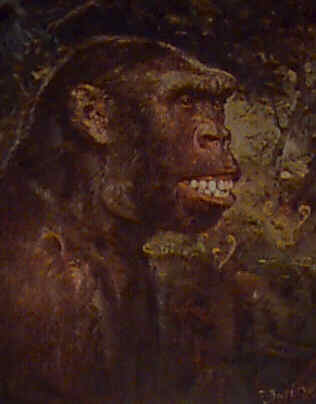 Could
not a few of the others have survived into more recent times?
Actually, they were more than cousins, those H. erectus people:
they were, in a sense, our parents. Some of them, after all, gave
rise to us. Could we and they have interbred? Did some of our kind have
children by some of their kind? Would not the fruit of such a union leave
identifiable bones in testament? Are such hybrid bones to be found?
Would we call such a being an archaic human?
Could
not a few of the others have survived into more recent times?
Actually, they were more than cousins, those H. erectus people:
they were, in a sense, our parents. Some of them, after all, gave
rise to us. Could we and they have interbred? Did some of our kind have
children by some of their kind? Would not the fruit of such a union leave
identifiable bones in testament? Are such hybrid bones to be found?
Would we call such a being an archaic human?
Well, yes. Maybe. Possible hybrid remains are to be found in several places around the globe. One, not so well known, archaic 'homeland' appears to have been southern Australia1. See my article in prep for the Cryptozoology Review for a list of references.
It is clear that, in comparatively recent times,
Australia was inhabited by two distinct types of human, one modern
looking, the other archaic. Moreover, it now appears more than possible
that the Australian continent was colonised by both H. sapiens sapiens
and H. erectus1. Could the Australian mainland
have seen the hybridisation of two species of Homo to produce the
results we see at Kow Swamp and elsewhere?
Are there any discoveries with a more recent date than these? It appears there are.
In the 1970s a paper in a French language journal indicated that remains of "archaic" humans found in New Caledonia were a mere 300 years old2. That is to say, it now appears there is documented evidence that archaic humans lingered on into modern times. The question must therefore be asked : if only three hundred years ago in New Caledonia, why not elsewhere up till the present? (I haven't heard how solid the C14 date is on this one yet. If any reader knows more, by all means speak?)
Obviously, the survival of "archaic" humans into the present
day, possibly a separate species arisen from intermarriage of our own kind
with H. erectus would be of extreme scientific interest. It would
also carry the heaviest ethical burden in terms of our behaviour towards
them, should they in fact be found still to exist.
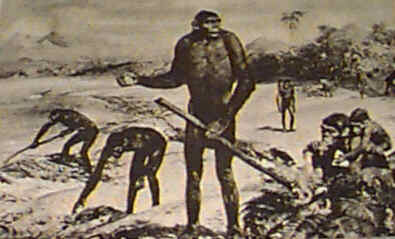 OK,
let's ask it. Do Yowies exist? Could the so called Yowie
be a relict archaic human, possibly a being we know as Homo
heidelbergensis? (See NOTE #3 below.)
OK,
let's ask it. Do Yowies exist? Could the so called Yowie
be a relict archaic human, possibly a being we know as Homo
heidelbergensis? (See NOTE #3 below.)
All I'll say is that a scenario like that is about as unlikely as it's possible to get. This side of the completely impossible, that is. On the other hand, check out the links below. All I know is that sightings of a large, hairy biped in Australian forests are regularly communicated to the general media and to web sites like mine. Inconveniently, not all the reportees can be written off as drivelling ratbags. Tracks are also regularly reported and photographed.
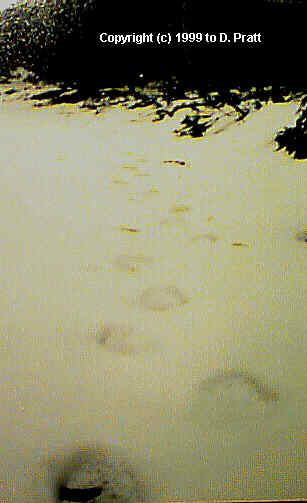 All
I will hazard is that if a seven or eight foot tall, hairy dude suddenly
popped outa the bushes in front of you, while you were strolling along
minding your own business as they say, how would you later
describe the event?
All
I will hazard is that if a seven or eight foot tall, hairy dude suddenly
popped outa the bushes in front of you, while you were strolling along
minding your own business as they say, how would you later
describe the event?
So why trouble to write this up if it's all a load of malarkey?
Well, I guess, you never know. Serendip. The Australian region is the only place where scientifically attested remains of relatively recent date have been found which just might have something to say about the unknown hominid phenomenon, a la Bigfoot, the Yeti and the Yowie. The idea outlined here provides the only (more or less!) workable mechanism whereby such a thing could come to pass.
OK, it's a big leap in the dark, (almost) completely unfounded, scientifically dubious (extremely!) and (almost certainly!) utterly ridiculous. All this I know already so please - don't bother to point it out.
But just remember this : if in the unlikely event it ever turns out there really is something to the Yowie legend - you read it first while on the Quest forThylacoleo. Staking my claim is all.
Click here ARCHAICS.ZIP for
a scanned set of JPEGs (ZIP, 600K) of the article. Copyright is retained
by the relevant authors and/or publishers.NOTE: My thanks to Michel
Raynal for alerting me to this one.
NOTE #2 : A book that definitely should be on your shelves is Quaternary Extinctions: A Prehistoric Revolution, Paul S. Martin & Richard G. Klein, eds. University of Arizona Press, Tucson 1984. Available from Amazon.
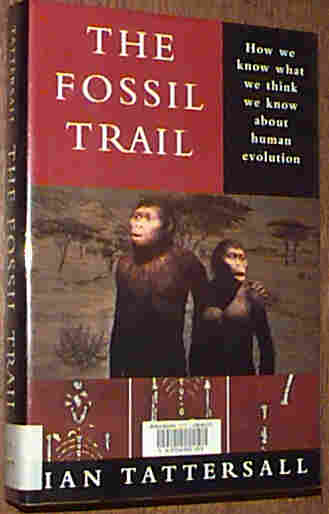 NOTE #2A : One that I'd recommend for an overview of human evolution is
The
Fossil Trail by Ian Tattersall.
Available
from Amazon.
NOTE #2A : One that I'd recommend for an overview of human evolution is
The
Fossil Trail by Ian Tattersall.
Available
from Amazon.
NOTE #3 : The appellation Homo heidelbergensis was, I think, proposed by the noted palaeoanthropologist Ian Tattersall as a catch-all species name for those hominids dating from after about 500 kybp who are neither H. sapiens, nor H. neanderthalensis nor H. erectus. In other words for the archaics. The trouble is that the term is then inclusive of beings who, in all likelihood, were the ancestors of modern H. sapiens, as well as others who assuredly were not. It is a group that shows a lot of variability for a single species. Rather too much I'd say. There is also the time frame of half a million years to take account of.
For example, the Jebel Irhoud 1 cranium may well belong to an ancestral human. But what about utterly weird looking creatures such as the Petralona specimen? At a date of possibly 400 kyb, it can't belong in the sapiens line, if the Out-of-Africa school is correct, and it can't represent a hybrid between sapiens and erectus either. A line of erectus morphing into neanderthalensis maybe? Whatever the case, it's obvious that archaics dating from before, say, 150 kyb don't represent sapiens/erectus hybrids. If outside Africa they can only be be representatives of populations diverging from erectus stock. Diverging into what, though? Not modern sapiens, that's for sure.
On the other hand, what can we say about archaics who date from after the time when H. sapiens were in the world? Those who lived more recently than about 150 kyb that is?
MORE REFS :
Multiregional Evolution: the Fossil Alternative to Eden. In: The Human Revolution: Behavioural and Biological Perspectives on the Origins of Modern Humans, edited by P. Mellars and C.B. Stringer. Edinburgh University Press, Edinburgh. pp. 62-108.
Wolpoff, M.H., A.G. Thorne, J. Jelínek, and Zhang Yinyun 1994 The Case for Sinking Homo Erectus. 100 Years of Pithecanthropus is Enough! Courier Forschungsinstitut Senckenberg 171:341-361.
Hawks, J., S-H. Lee, K. Hunley, and M.H. Wolpoff 2000 Bottlenecks and Pleistocene Human Evolution. Molecular Biology and Evolution 17(1):2-22.
Wolpoff, M.H., J.D. Hawks, D.W. Frayer, and K. Hunley
2001 Modern Human Ancestry at the Peripheries: A Test of the Replacement
Theory. Science 291:293-297.